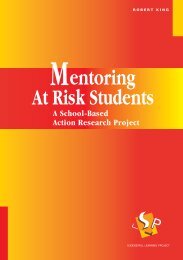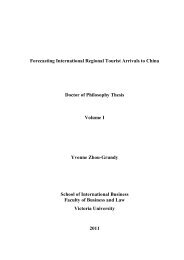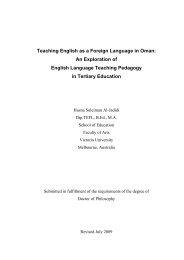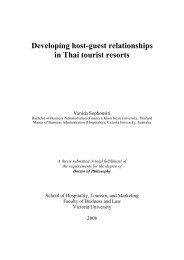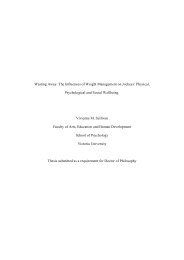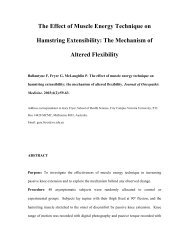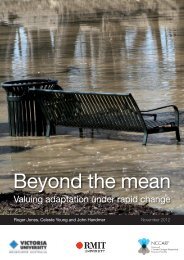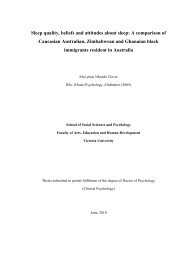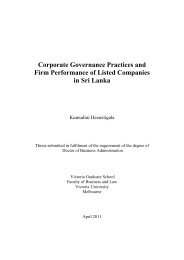Providing Education and Training for At Risk ... - Victoria University
Providing Education and Training for At Risk ... - Victoria University
Providing Education and Training for At Risk ... - Victoria University
- No tags were found...
You also want an ePaper? Increase the reach of your titles
YUMPU automatically turns print PDFs into web optimized ePapers that Google loves.
ConclusionPathways are notoriously difficult to lay bare: in education, some are well trodden, <strong>and</strong>others are obscured except to the initiated. VET in general has suffered because itsobscurity alongside the well-lit tarmac to tertiary has caused young people who canbenefit from such vocational studies to ignore them. Only in the last few years has this begunto be redressed (Dwyer et al. 1997). But at the same time, the whole notion of a pathway hascome under scrutiny. In the ‘new work’ environment, with structural (<strong>and</strong> long-term)unemployment, <strong>and</strong> short-term jobs more than ever the norm, young people in particular areconstructing or ‘packaging’ their experiences in ways that their parents may regard as ephemeral<strong>and</strong> short-sighted. A linear ‘pathway’ may be an unhelpful metaphor, <strong>and</strong> there<strong>for</strong>e an inaccuratepolicy assumption (Dwyer 1997). Program design <strong>for</strong> those returning to study from experiencesof vulnerability (or ‘riskiness’) must take that experiential context seriously, <strong>and</strong> build on thelateral ‘packaging’ of learning, rather than conclude, hastily, that linear ‘pathways’ areobligatory. Life <strong>for</strong> many young folk is a zigzag: a pastiche of challenges. Educators whoproblematise these as ‘alienation’ have some quick talking to do.In concluding this Review, we return to the research summary with which we began, but inmore detail, in the light of the ensuing analysis, which has shown how multi-dimensionalvulnerability to unsuccessful outcomes can be. But it has also shown that worthwhile programdesign starts with participants’ underst<strong>and</strong>ings of their worlds, then builds community supportin various ways into extending those underst<strong>and</strong>ings, the school or TAFE college being themost prominent institutional expression of ‘community’. Given that, we endorse the followingsummaries.Withers <strong>and</strong> Batten (1995: 33) state that ‘the characteristics of effective programs’ (drawingupon Wuest 1992), are those which:• have clear goals <strong>and</strong> objectives• are comprehensive, encompassing the full scope of—educational provision—employment—skills training—support services• are locally administered <strong>and</strong> governed• are designed in such a way as to reflect (‘are tied to’) the economic <strong>and</strong> social realities ofthe community• are given strong program leadership by a director• are coordinated with other services available to youthAccording to Withers <strong>and</strong> Batten, Wuest (1992) goes on to state that programs are located inplaces which minimise fears <strong>and</strong> a sense of past failures. For example, schools would not beused where programs were intended <strong>for</strong> substance abusers who were also early school leavers.The best class size is thought to be small where the ratio to leadership is 1




